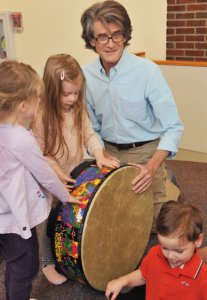
You may be wondering if it’s time to sign your child up for formal music instruction, like piano lessons. Music Together Founder/Artistic Director Ken Guilmartin has the following advice.

Music lessons can be a frustrating experience for a child who is not developmentally or musically ready for them. Most children—even the obviously musically inclined—can benefit from waiting a little longer to start traditional lessons than you might think.
To have a good chance of enjoying and embracing formal music study, a child must have a readiness that goes beyond the traditional prescription of being able to sit still for fifteen minutes, count from 1 to 5, and know the letters A to G. It’s important to consider your child’s temperament, physical development, and level of tonal and rhythmic competence before signing them up for lessons, and to ask yourself what you as a parent want for your child.
The nature of traditional lessons
It helps to be clear-eyed about the nature of traditional instrument lessons. They involve learning to read music, which is a complex cognitive process, and they require a high degree of hand-eye coordination. They are inevitably product-oriented, focused on semi-regular recitals at which the student’s learning will be displayed and judged. Reflect on whether your young child is developmentally ready for the pressure of performing a piece in public. Practicing a piece to become performance-ready requires persistence, patience, and commitment, and music study will not magically produce these qualities in a child who is not already showing some sign of them. If your child is easily frustrated and has little patience for repetitious tasks, it’s probably better to continue for a while longer with non-formal music and movement experiences like Music Together classes, or if offered in your area, Rhythm Kids.
The need for basic music competence
Temperament and developmental readiness are only part of the equation. Even an exceptionally mature and motivated child can flounder in traditional lessons without the most important readiness factor of all: basic music competence (BMC). This is the ability to sing in tune and move with accurate rhythm. Given a sufficiently rich music environment, tonal and rhythmic competence develop as naturally in a child as their ability to speak their native language. In fact, in world cultures where music remains an integral, active part of daily life, children often achieve BMC at around age three, just about the same time they are developing competency in language.
In our culture, however, there is a delay in acquiring basic tonal and rhythm competence. Children grow up apparently surrounded by music but actually at a slight remove from it: their music experiences are often passive, received from recordings or television and offering little opportunity for the active engagement needed for learning. As a result, many children don’t learn to sing in tune and move with accurate rhythm until age six, seven, or beyond.
Imagine the consequences of this within the context of a music lesson. A child without tonal competence will have difficulty recognizing whether they are playing the correct melody: they may not even have an aural understanding of what makes one note “right” and another “wrong.” If they lack rhythmic competence, they will likely have trouble understanding the values of notes or keeping a steady tempo. If a child cannot “speak the language” of music by singing in tune and moving with accurate rhythm, how can they be expected to become literate enough to read music? As with language, music mastery happens first at the aural/oral level, through plenty of direct exposure.

Creating a sound music environment
Therefore, the best way to help your child prepare for eventual music lessons is to provide a rich environment with active music experiences. Young children learn through play, so singing, saying rhythmic rhymes, and moving to music are not only fun but beneficial. It’s also an excellent idea for any parent who has dreams of their child playing an instrument to begin taking lessons themselves. This will pique the child’s curiosity and present a powerful role model.
Children who have been in Music Together classes often demonstrate tonal and rhythmic competence relatively early—perhaps by age three or four—depending on how many semesters they’ve been in the program. While it may be musically possible for such children to start instrument lessons, our own inclination is to allow children a little more time to develop emotionally and physically before starting traditional lessons which involve reading music. In the meantime, they can explore rhythm instruments and strengthen their singing and movement skills, all of which will be useful to later instrument study. An ability to improvise and literally “play” music is invaluable to any musician.
Some general recommendations
Children develop at different rates physically, emotionally, socially, and musically, so the following can be only approximate guidelines for what might be best at different ages.
- Threes and fours will continue to thrive in group music classes that allow for a direct, playful experience of music and movement. Create a music environment at home, too, by integrating spontaneous music-play into your daily life.
- Fives and sixes will continue to thrive in group classes like Rhythm Kids, where they can begin to apply basic music skills to a variety of music and movement experiences, including drumming, improvisation, singing, choreographed dance, musical games, and age-appropriate interactions with music notation.
- Seven to nine is often a good time to explore traditional lessons. Choose a teacher you think is a good temperamental match for your child. It’s more important at this point for them to fall in love with their instrument than work with a noted maestro. (That can come later!)
- Ten and older is not too late to begin! The older child tends to be focused and to progress rapidly. Sometimes, however, they may find beginner music to be “babyish,” so the choice of materials will be crucial. Try Béla Bartók’s Mikrokosmos, a series of books with musically interesting exercises that older children find appealing.



